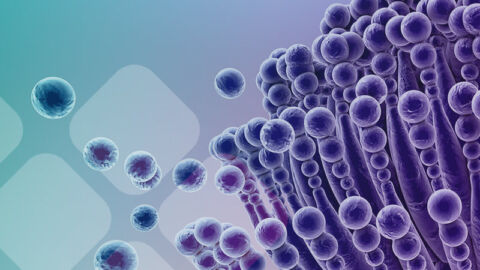There are approximately 100 species of clostridia bacteria that can inhabit the gastrointestinal tract of humans. Not all of these clostridia are disease causing, but a certain few can lead to serious illness in susceptible individuals. There are 5 main species of clostridia known to cause disease: Clostridia botulinum, Clostridia perfringens, Clostridia tetani, Clostridia sordellii, and Clostridia difficile. This article will focus on the role of Clostridia difficile (C. difficile), and its production of various gastrointestinal toxins in human illness.
What Are Clostridia Bacteria?
Clostridia difficile, like all clostridia bacteria, is an obligate anaerobe. This means it is an organism that thrives in an oxygen devoid environment and is susceptible to being killed by normal atmospheric oxygen. It is unique in its ability to survive in hostile environments in part because of its spore development. Clostridia spores, the reproductive cell of clostridia, have thick cell walls which resist heat and antimicrobial compounds. These spores of clostridia are highly contagious and can be spread person to person even from individuals without symptoms of clostridia overgrowth.
C. difficile is a complex species of clostridia because of the various toxins it can produce. There are certain strains of C. difficile that produce compounds known to alter mitochondrial function by interfering with various steps in Kreb Cycle metabolism decreasing the amount of nicotinamide adenine-dinucleotide (NADH) used by the electron transport chain for adenosine-triphosphate (ATP) production (1). Other C. difficile strains create neurochemical compounds that disrupt dopamine production leading to various issues with regards to mental health. However, the most commonly known toxins produced by C. difficile are those that disrupt gastrointestinal function and in some individuals can lead to serious health problems.
The Prevalence of C. difficile Associated Disease
The rates of C. difficile infections leading to serious illness and death have been on the rise. According to the Centers for Disease Control even as recent as 2011 there were approximately 450,000+ documented case of Clostridium difficile infections (CDI) and upwards of 29,000 deaths (2). A large number of individuals who have an initial episode of CDI will develop at least one recurrence of the disease. The recurrence rates for CDI are high, in part because of the complex nature of C. difficile, and its spore forms that resist antibiotic intervention.
One of the problems with C. difficile is that not only can it lead to serious illness in susceptible individuals, but that it can be found in people, even children, who may not necessarily be suffering with primary issues related to C. difficile. For example, a paper in 2010 out of Poland (3) discussed the prevalence of C. difficile in fecal samples taken from 178 children ages 2 months to 2 years who were hospitalized for a variety of reasons. Their stools where examined for the presence of C. difficile Toxin A and B, the two main intestinal toxins known to trigger chronic diarrhea and bowel inflammation. The percentage of children infected with C. difficile was 68.6% and many of these children were not acutely sick from C. difficile. However, as mentioned previously, toxin A and toxin B from certain strains of C. difficile can lead to serious problems.
The Role of Toxin A and Toxin B
These two toxins are the main virulence factors related to mucosal damage from C. difficile. Toxin A and B are capable of causing mucosal damage resulting in digestive tract inflammation leading to either clostridia difficile associated diarrhea (CDAD) or Pseudomembranous colitis (4).
Toxin A is categorized as an enterotoxin, which means it is a toxin released by microorganisms that target the digestive system. It functions by changing host cell metabolism and tight junction formation. This can lead to mucosal cell damage, fluid accumulation and even cell death. Toxin A is considered to be the main cause of CDAD as it causes intestinal villi and brush border destruction. In severe cases of Toxin A production, it can lead to ulceration formation seen in Pseudomembranous colitis.
Pseudomembranous colitis is a type of inflammatory bowel disease of the colon that manifests with various ulcerations from mucosal damage and the development of a “pseudo” membrane (aka. ‘inflammatory membrane’), that overlays the site of mucosal injury. This inflammatory membrane is an accumulation of fibrin and inflammatory and necrotic cells that appear as a yellowish globule spread throughout the colon. In the late 1970s it was determined that C. difficile via the production of various toxins, was the causative organism for Pseudomembranous colitis.
Like Toxin A, Toxin B also plays a significant role in damage to the mucosal lining of the digestive system. Toxin B is categorized as a cytotoxin which means it is toxic to cells. Examples of cytotoxins would be chemicals produced by the immune system that damage other cells in the body. Bee venom, as well as poisons from spiders or snakes, are all classified as cytotoxins.
Toxin B causes major cellular disruption by interfering with signaling pathways, tight junction formation, formation of the cytoskeleton of the cell, and derangement of overall cell structure. It is a major virulence factor of C. difficile leading to vascular swelling and hemorrhaging. Also, Toxin B can not only have local inflammatory effects in the digestive system, but also systemic effects through its production of proinflammatory cytokines such as Tumor Necrosis Factor-αlpha.
It was felt for many years that serious bowel inflammation from C. difficile was generated by a single toxin, but both toxins are now known to be capable of causing mucosal damage.
Treatment and Testing
Treatment of C. difficile infections are mostly done by antibiotics. The two most common antibiotics are oral Flagyl (metronidazole) and oral Vancomycin (vancocin). Traditional intervention calls for 7 to 10 days of either antibiotic. As mentioned previously recurrence rates for C. difficile can be high, primarily because of C. difficile spore formation. There is a trend in C. difficile treatment to use cyclical courses of either antibiotic to aide in reduction of recurrence rates and increase clinical outcomes.
Stool testing for C. difficile is effective and is used as a primary diagnostic tool analyzing for the presence of Toxin A and Toxin B. Prior to stool testing direct visualization of inflammatory membranes was used through colonoscopy or sigmoidoscopy.
If either Toxin A or B is detected on stool pathogen screening the practitioner needs to correlate the information to the clinical presentation of the individual and treat accordingly or refer to a specialist for further evaluation. Not everyone with C. difficile will be symptomatic of intestinal disease so each situation needs to be evaluated individually. However, the presence of Toxin A or Toxin B found on stool pathogen testing certainly documents the presence of a strain of C. difficile. The individual should be treated appropriately.
Dr. Kurt N. Woeller is an author, international speaker, practicing clinician and founder of Integrative Medicine Academy (www.IntegrativeMedicineAcademy.com), which is an online training academy that provides various courses for health practitioners interested in integrative medicine.
REFERENECS
1. Richard E. Frye, et. al. Gastrointestinal dysfunction in autism spectrum disorders: the role of the mitochondria and the enteric microbiome. Microbial Ecology in Health and Disease. Volume 26, 2015.
2. Lessa, FC, et.al. Burden of Clostridium difficile infection in the United States. N. Engl J Med, 2015;372:825-834.
3. Prevalence of Clostridium difficile in the gastrointestinal tract of hospitalized children under two years of age. Med Dosw Mikrobiol; 2010;62(1):77-84 (Poland).
4. (Kuehne SA, Cartman ST, Heap JT, Kelly ML, Cockayne A, Minton NP; October 2010. “The role of toxin A and toxin B in Clostridium difficile infection”. Nature 467 (7316): 711–3.




